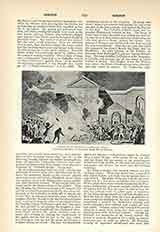

Gorgonius, Saint, Martyr, suffered in 304 at Nicomedia during the persecution of Diocletian. Gorgonius held a high position in the household of the emperor, and had often been entrusted with matters of the greatest importance. At the breaking out of the persecution he was consequently among the first to be charged, and, remaining constant in the profession of the Faith, was with his companions, Dorotheus, Peter, and several others, subjected to the most frightful torments and finally strangled. Diocletian, determined that their bodies should not receive the extraordinary honors which the early Christians were wont to pay the relics of the martyrs (honors so great as to occasion the charge of idolatry), ordered them to be thrown into the sea. The Christians nevertheless obtained possession of them, and later the body of Gorgonius was carried to Rome, whence in the eighth century it was translated by St. Chrodegang, Bishop of Metz, and enshrined in the monastery of Gorze. Many French churches obtained portions of the saint’s body from Gorze, but in the general pillage of the French Revolution, most of these relics were lost. Our chief sources of information regarding these martyrs are Lactantius and Eusebius. Their feast is kept on September 9
There are five other martyrs of this name venerated in the Church. The first is venerated at Nice on March 10; the second, martyred at Antioch, is commemorated on March 11; the third, martyred at Rome, is honored at Tours on March 11; the fourth, martyred at Nicomedia, is reverenced in the East on March 12; while the fifth is one of the Forty Martyrs of Sebaste, whose feast is kept March 10.
JOHN F. X. MURPHY

